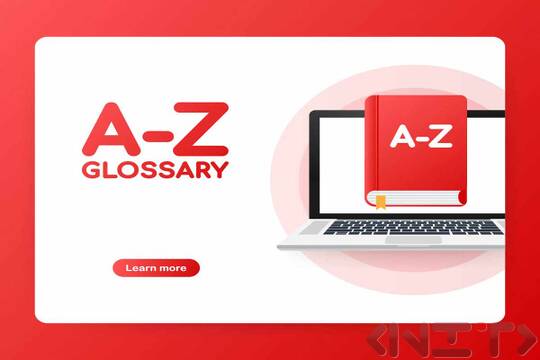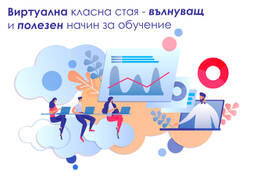
Online learning has become the primary method of adult education. Whether you work in the corporate world or in higher education, you've probably taken a course or watched a webinar using a learning management system (LMS) and are no stranger to online education.
Although many of us have a basic level of experience in online learning, the ever-evolving technology and terminology can start to make it difficult.
That's why we've compiled this A to Z glossary of eLearning terms and phrases to help you navigate the world of online learning.
Vocabulary:
Asynchronous learning, API, learning analytics
Asynchronous learning refers to online learning that one conducts at one's own pace. It does not interact with an instructor or other students in real time. Instead, learners access uploaded materials such as webinars, presentations, and PDFs. Learners asynchronously complete tasks and activities at their convenience.
The abbreviation API stands for "application programming interface". In the context of e-learning, API allows two different software applications to interact and exchange data. APIs can be used to extend the features available in your LMS by pulling in useful information and functionality from another system.
Learning analytics refers to the measurement, collection, and reporting of data about learners and their progress in learning programs. Institutions and organisations use this data to understand how their users learn. They also use the data to optimize the learning environment to achieve better educational outcomes.
Vocabulary:
Cloud-based learning
Cloud-based refers to services, applications, or resources that are accessible to users via the Internet. Commonly used cloud solutions include software as a service (SaaS), infrastructure as a service (IaaS), and platform as a service (PaaS).
Vocabulary:
Built-in learning outcome reports, Virtual Learning Environment (VLE) and Virtual Reality (VR)
Embedded reports are essentially data sets retrieved and displayed after a query. An example is a report that contains a list of students enrolled in a course, containing another report for each learner. The embedded report provides quick access to information related to a particular person's learning path data without the need to leave the course list.
A Virtual Learning Environment (VLE) is an online platform used for educational purposes. Examples of VLEs include online courses such as e-learning, reading and information sites with self-assessment of skills or other forms of virtual learning.
Virtual reality (VR) fully immerses users in audiovisual experiences in which they participate from a first-person perspective through the use of a VR headset. These experiences are designed to help learners synthesize and assimilate more information.
Video Tutorials, Video Learning Interactive Videо
Video Tutorials - Video tutorials are videos that present specific training or learning material. They can come in a variety of formats from simply recorded lectures or demonstrations to more complex video projects that include animations, visuals and interactive elements. The aim of video tutorials is to provide a convenient and accessible way of learning that can be used in educational institutions as well as online learning. Video tutorials allow learners to learn at their own pace and benefit from re-watching the material and also communicate with the teacher or other students via online platforms.
Video training - Video training is a form of training that uses video material as the main tool for transferring knowledge and skills. It can be presented in a variety of formats, such as lectures, tutorials, demonstrations, etc., and can be offered both in the classroom and online. Video learning provides a convenient and easy way to access learning material that can be viewed and replayed repeatedly to reinforce learners' knowledge and skills. It can also be customized to meet the needs and interests of individual learners and facilitate the learning process. Video learning is becoming increasingly popular due to its simplicity of use and effectiveness in training in a variety of fields including education, business and marketing.
Interactive Video - Interactive video in training is video material that allows the viewer to interact with its content. This can be accomplished by including elements such as maps, quizzes, tips, and other features that the user can use to expand their knowledge and skills in the specific area. In an interactive video, the viewer can control the pace of learning and return to lessons already reviewed or move forward to the next. Such videos are often used for educational purposes as they provide a more active and engaged learning process.
Vocabulary:
Ready content, gamification
The term "ready-made content" refers to content that is sold in a ready-to-use format without customisation or personalisation. In e-learning, the term usually describes pre-prepared modules that can be added to a course. It can also refer to entire pre-prepared courses.
Gamification is an instructional technique designed to engage students and increase their learning. "Gamified" learning incorporates game elements such as scoring, rewards, and leaderboards to promote competitive learning, social connection, and a sense of measurable progress. This type of learning typically increases engagement and retention of the material.
Vocabulary:
Differentiated and direct learning, digital learning objects, digital library accessible, learning, augmented reality (AR), LMS provider
The term 'differentiated learning' refers to the provision of a diverse range of different learning modalities that meet the needs of different groups of people with different abilities and learning styles within a community of learners. The educator can deliver learning materials in different forms and through different tasks to different groups of learners. This ensures that all learners are adequately challenged without the content being too difficult.
Direct instruction refers to learning activities and assessments that are initiated by the teacher and completed by the student. They are traditionally found in the course syllabus in the LMS and mimic face-to-face classroom instruction.
Digital Learning Objects (sometimes referred to as DLOs or simply 'learning objects') are digital resources that can be reused to support learning. Examples include webinars, presentations and interactive lessons.
A digital library uses technology to store resources electronically. They can store articles, books, and other relevant reference sources for organizations or educational institutions.
Accessible learning means providing all people with equal access to information, educational experiences and services, regardless of their abilities or disabilities. In online learning, this means developing courses that include assistive tools to meet potential student needs, such as adding captioning for the hearing impaired.
Augmented Reality (AR) is an interactive experience that involves overlaying digital images, auditory or other sensory information onto a real environment. A device such as a smartphone projects computer-generated sensory information onto the user's view of the real world (often through the device's camera function), which creates a composite image and enriched experience for the user. A popular example of commercial use of AR is the mobile game Pokémon GO.
The LMS vendor is the organization that configures your learning management system and also provides operational support. Some LMS vendors provide additional services, such as content creation, exam delivery, or LMS training courses that train your team on how to work with the new learning platform.
Vocabulary:
E-learning
E-learning is short for "e-learning". It is the acquisition of knowledge through electronic technology. In other words, e-learning happens when people use computers or mobile devices to learn.
Vocabulary:
H5P and Hybrid Learning
H5P stands for HTML5 Package. This open source content collaboration framework integrates with learning management systems so users can create, share and reuse interactive content.
Like blended learning, hybrid learning involves a combination of face-to-face and digital learning. In hybrid learning, instructors teach students both online and in person using tools such as videoconferencing. Distance learners typically stay remote and complete all activities online, while in-person learners attend classes with the instructor face-to-face.
Vocabulary:
Kirkpatrick model, instructor-led courses, instructor-led training
The Kirkpatrick model is a globally recognised framework for evaluating the effectiveness of courses and training programmes. Developed by Dr. Donald Kirkpatrick in the 1950s, it is designed to help L&D professionals - evaluate their training programs through measurement:
- Learners' reactions to learning content;
- The extent to which learners cope with the information during the training course;
- Learners' behaviour after the training course;
- The impact of the training course on the organization's target outcomes
It was modified in 2010 and is still in use today by organizations in many sectors.
Instructor-led courses and instructor-led training are two terms for the same concept. They refer to the idea that learning takes place under the direction of an instructor who assigns activities and sets the pace for students.
Instructor-led training is the preferred term in corporate training environments. In secondary and higher education, it is referred to as instructor-led courses.
Vocabulary:
Machine learning, microlearning and multitasking, performance monitoring
Machine learning refers to the ability of a system to gather and use information without being guided by explicit programming. Through machine learning, artificial intelligence systems can adapt and change based on responses from earlier input. An example of machine learning is a search algorithm that ranks webpages in higher positions based on the number of previous searchers who selected those webpages first.
Microlearning is a method of learning in which tasks and skills are reduced to the basic components, taught in very small lessons or activities. The process reinforces skills with repetition of small parts interspersed with other tasks, and students' retention of skills and knowledge is regularly assessed to determine the degree of mastery. Proponents argue that it allows for a more flexible, variable-paced learning environment that is accessible to every student.
The term multi-tenancy refers to an LMS that allows separate environments for each division or department within a company to customize their learning and development activities in line with best practices at work. The concept originated from web-based CMS systems that allow the administration of multiple websites from a single multi-node system framework.
Performance monitoring is a process that tracks the progress of individual members, teams and departments in achieving goals. As learners progress through training courses, instructors and administrators use monitoring to track which members of the organization may need additional assistance or feedback to progress toward course objectives within established parameters.
Vocabulary:
Open source , face-to-face training, Face-to-Face (F2F) and flipped classrooms, General Data Protection Regulation GDPR, compliance training is material
The term face-to-face learning (sometimes stylized as F2F) means that students and teachers are together in a physical classroom or other learning environment.
In the flipped classroom, the traditional lecture or seminar is flipped. Students are given access to course materials before they meet for the course. Students then spend time in the classroom collaborating with each other and doing activities that encourage higher-order thought processes, such as analyzing and evaluating a concept. The teacher assumes the role of facilitator rather than lecturer.
Open source refers to the practice of sharing software code and allowing others to use it in their own projects as needed. The term can be used to refer to entire programs developed collaboratively and in a way that allows other developers to modify them. It can also refer to pure source code. Open source platforms are very popular as they can be adapted to the needs of companies and educational institutions.
Compulsory training
OSHA training refers to the mandatory compliance training in every industry in the United States according to the Occupational Safety and Health Administration (OSHA). The organization's L&D team must create training courses that comply with OSHA regulations. Training must be relevant to the specific job and tailored to the specific work performed by a department. There are other requirements regarding cross-training and safety protocols.
Mandatory compliance training exists all over the world. Click on the links below for more information on specific areas:
General Data Protection Regulation (GDPR). This is a data protection regulation that applies to all member states of the European Union. It aims to give citizens greater control over their personal data while protecting privacy. If any of your learners reside in the European Union, your online training program must comply with GDPR when storing and processing learner data.
Compliance training is material created by a third party that is purchased and used by others. Organizations often choose canned content to offer their users expertly designed online training courses while saving time and money by not creating the resources themselves.
Compliance training is the process of educating an organization's employees about the laws, rules, and regulations that apply to their daily work. This type of training protects businesses from liability by improving employee awareness of local, state, and regional laws that apply to their industry.
Training (and everything that goes with it)
A digital education glossary would not be complete without an extensive entry on learning-related terms. Learning itself is the acquisition of new knowledge. Below are eight additional terms for learning that have evolved with the advent of digital technologies.
Learner-centred learning
Learner-centred education is the idea that the most important aspect of learning is the learner. The focus is primarily on the knowledge and abilities that the learner acquires as a result of the course, as well as how competently they can perform the desired outcomes. A key component of this learning model is that Digital Learning, which adapts to each participant, can be considered learner-centered.
Learning ecosystem
The term 'learning ecosystem' refers to the overall understanding of the platforms, processes and people that deliver learning and development in an organisation or institution. As with ecosystems in the natural world, the interaction between each element of a learning ecosystem is significant. When building a learning ecosystem, it is important to consider how each individual element can combine to provide the best effect in the learning process.
Learning Experience Design (LX)
Learning experience design (or simply LX design) is an area that focuses on the individual learning moments that learners encounter during the course. The learner is the focus and their experience as they move through the course is a top priority for these designers.
LX designers strive to create an experience that reinforces learning, provides opportunities for synthesis and analysis that lead to better learning, and assesses how learners use that lesson as part of an overall educational process.
Platform for learning practices
The Learning Experience Platform (LXP) is a user-centric software platform for hosting formal and informal learning materials. These materials can be in the form of articles, podcasts, videos, etc. Materials are created by L&D educators and corporate teams, learners, or external vendors. LXP provides users with a single point of access for self-directed learning.
Vocabulary:
Personal, customized learning, checking and professional development plan
In learning design, personas (personalities) are fictional profiles describing relevant characteristics of potential target learners. Good personas are based on real user data and behavior. Personas can help designers create learning experiences that are relevant and easy to use and understand.
Personalized learning plans are flexible educational models that allow learner-defined goals to guide the content and difficulty of the material. This style of teaching is gaining popularity in both physical and digital learning environments.
Proctoring (also known as electronic proctoring or online proctoring) refers to software that monitors students as they take exams and other high-stakes assessments. Exam participants can be monitored via the camera on their device. Their online activity is also tracked, and administrators are notified if an examinee attempts to visit other websites during the assessment. Some exam software does not allow students to leave the testing window during active assessment. The goal of online proctoring is to improve the academic honesty of digital exams.
Professional development (sometimes referred to simply as PD) refers to any continuing training, education, or mentoring designed to deepen a person's skills in a particular area and improve proficiency in relevant knowledge. It can refer to continuing education programmes that lead to credentials required for advanced training and/or to certification in specific skills, such as process management. It can also refer to general training and enrichment designed to help maintain proficiency while introducing changes in institutional best practices.
Vocabulary
SCORM, self-directed learning, self-paced, self-paced training, single sign-on, blended learning, social learning, talent management system (TMS), content management systems, closed source systems
The acronym SCORM stands for shared content object reference model. It refers to a set of tools developed by the U.S. Department of Defense-funded Advanced Distributed Learning (ADL) initiative. The SCORM standard has been adopted in many industries and niches, including education. The model creates easily referenced course progress data in the form of points and earned percentages, providing learners and instructors with a quick reference point for learner progress within a linear course design model.
SCORM is among the most used data standards in education, although alternatives that update and extend it have already outpaced its features and ease of use.
Independent learning describes a learning style that relies on the student's individual inquiries to guide the process of discovering relevant information. It has a less formal structure than many other styles, but with interaction and collaborative learning creates a flexible style suitable for many asynchronous courses.
Self-paced training means that your LMS is hosted on your organization's servers instead of by a third-party cloud provider. Self-hosted eLearning is typically managed internally and updates must be done manually. Only users who have access to the server can access LMS content.
Self-paced learning, on the other hand, allows the learner to control how much material to process in each session, how long it takes them to master the material, and sometimes even the order of the learning objectives for that particular unit. For students to be successful, the learning environment must be organized by a facilitator before students begin working with the materials.
Single sign on login (sometimes referred to as SSO) is a login configuration that provides users with a set of related but separate sites and services with a single username and password for verification. It is popular with educational CMS systems, social media platforms, and even many device manufacturers.
Blended learning is a teaching method that integrates digital technology and face-to-face interaction to create a seamless learning experience. This method gives students some flexibility and control over their learning, providing them with greater engagement with the process.
Social learning emphasizes interaction and discussion in a structured environment to promote greater retention of knowledge. Proponents of this style of learning argue that the engagement created in this format is also greater than in traditional classroom learning formats. The environment is often collaborative, but not always.
Talent Management System (TMS)
A Talent Management System (TMS) is an electronic environment with multiple participants in different roles. In this case, the system is used to manage not only training and development, but also compensation and benefits, recruiting, and often performance appraisals. The tool is useful for HR departments as it facilitates their record keeping across multiple axes, making it easy to collate employee development, job evaluations and promotion and pay adjustment history.
A content management system (CMS) is a software application that allows people to create websites and manage the content on the websites. A person who does not have much programming experience can build and manage their website using a CMS.
Closed source software means that the public cannot access the source code of a piece of software. In other words, only the person or organisation who created the software can change it. Some examples include Zoom, Microsoft Word and Adobe Creative Suite.
Vocabulary
User Acceptance Testing and User Tours through Software Interaction
User Acceptance Testing (UAT) is the final phase of the software deployment testing process. UAT occurs only after the implementation team has completed all necessary updates and debugging operations.
In this phase, sample groups of users are included in the testing to provide input on their experiences with the learning management system. This process can be used for both new features and new programs.
A user tour using the software allows instructional designers to demonstrate how the platform works in an interactive way, allowing users to navigate at their own pace. No matter how simple an LMS may seem, no design is guaranteed to be intuitive for any individual user.
Vocabulary
Webinar and wearables
A webinar is an online seminar designed for training or professional development. Participants interact in real time, typically watching a demonstration with an opportunity to ask questions and explore issues of interest. It is very effective as a simple learning tool and can be combined with asynchronous learning to create a more diverse course experience.
Wearable devices refer to devices that can be worn and interacted with to provide data to a computer system. The use of wearable devices such as response buttons or smart watches allows students to interact with the lesson in a way that can be recorded in the learning management system, adding offline experience and learning to the available data used by the system in assessing performance.
Vocabulary
xAPI
The term xAPI (also known as the Experience API) refers to an e-learning specification that collects data on a wide range of experiences that a user encounters. The data collected covers a user's online and offline learning experiences
If you would like us to add or if we have missed an important term - let us know!
We are ready to lend a hand and help you by designing your interactive e-learnin
Find out more about the products and services we offer HERE, contact us on tel. +359 878 685 304 or via the contact form below.







